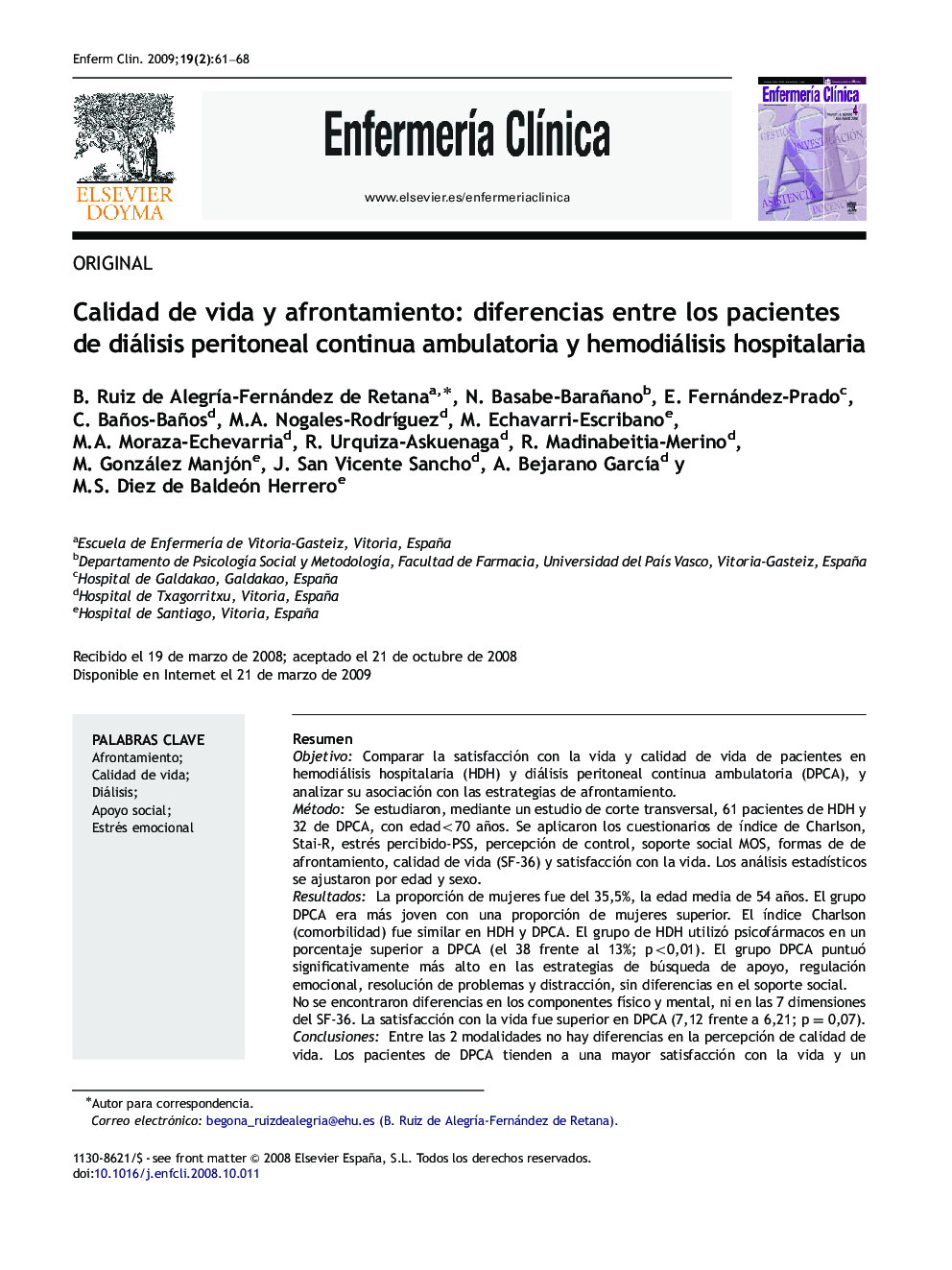| کد مقاله | کد نشریه | سال انتشار | مقاله انگلیسی | نسخه تمام متن |
|---|---|---|---|---|
| 2648492 | 1139138 | 2009 | 8 صفحه PDF | دانلود رایگان |

ResumenObjetivoComparar la satisfacción con la vida y calidad de vida de pacientes en hemodiálisis hospitalaria (HDH) y diálisis peritoneal continua ambulatoria (DPCA), y analizar su asociación con las estrategias de afrontamiento.MétodoSe estudiaron, mediante un estudio de corte transversal, 61 pacientes de HDH y 32 de DPCA, con edad<70 años. Se aplicaron los cuestionarios de índice de Charlson, Stai-R, estrés percibido-PSS, percepción de control, soporte social MOS, formas de de afrontamiento, calidad de vida (SF-36) y satisfacción con la vida. Los análisis estadísticos se ajustaron por edad y sexo.ResultadosLa proporción de mujeres fue del 35,5%, la edad media de 54 años. El grupo DPCA era más joven con una proporción de mujeres superior. El índice Charlson (comorbilidad) fue similar en HDH y DPCA. El grupo de HDH utilizó psicofármacos en un porcentaje superior a DPCA (el 38 frente al 13%; p<0,01). El grupo DPCA puntuó significativamente más alto en las estrategias de búsqueda de apoyo, regulación emocional, resolución de problemas y distracción, sin diferencias en el soporte social.No se encontraron diferencias en los componentes físico y mental, ni en las 7 dimensiones del SF-36. La satisfacción con la vida fue superior en DPCA (7,12 frente a 6,21; p=0,07).ConclusionesEntre las 2 modalidades no hay diferencias en la percepción de calidad de vida. Los pacientes de DPCA tienden a una mayor satisfacción con la vida y un afrontamiento más adaptativo (de regulación emocional y búsqueda de sentido), esto sugiere que podrían tener una mayor asimilación y control del proceso de enfermedad.
ObjectiveTo compare satisfaction with life and quality of life in patients receiving continuous ambulatory peritoneal dialysis (CAPD) and hospital hemodialysis (HHD) and to analyze their relationship with coping strategies.MethodsWe performed a cross-sectional study in 61 patients aged<70 years old under HHD and 32 patients receiving CAPD. We applied the Charlson Index, the State-Trait Anxiety Inventory (Stai-R), the Perceived Stress Scale (PSS), the MOS Social Support Survey, and the Short-Form 36 questionnaire for quality of life. Coping strategies, perceived control and satisfaction with life were also analyzed. Statistical analyses were adjusted by differences in age and sex.ResultsWomen accounted for 35.5% of the patients. The mean age was 54 years. The CAPD group was younger and had a higher proportion of women. Charlson Comorbidity Index scores were similar in patients receiving HHD and in those receiving CAPD. The use of psychoactive drugs was higher in the CAPD group than in the HHD group (38% vs. 13%; p<0.01). The CAPD group scored significantly higher in strategies of seeking help, emotional regulation skills, problem resolving and distraction. No differences were found in social support between the two groups.No significant differences were found in the physical or mental components or in the seven dimensions of the SF-36. Satisfaction with life was higher in the CAPD group (7.12 versus 6.21; p=0.07).ConclusionsNo differences in the perception of quality of life were found between patients receiving the two modalities. The CAPD group tended to show greater satisfaction with life and more adaptive coping strategies (emotional regulation and search for meaning), suggesting that these patients may have greater acceptance and control over the disease process.
Journal: Enfermería Clínica - Volume 19, Issue 2, March–April 2009, Pages 61–68